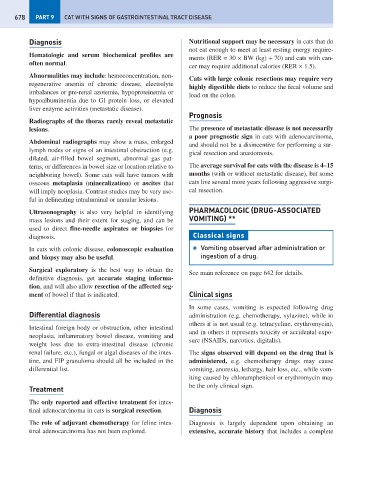Page 686 - Problem-Based Feline Medicine
P. 686
678 PART 9 CAT WITH SIGNS OF GASTROINTESTINAL TRACT DISEASE
Diagnosis Nutritional support may be necessary in cats that do
not eat enough to meet at least resting energy require-
Hematologic and serum biochemical profiles are
ments (RER = 30 × BW (kg) + 70) and cats with can-
often normal.
cer may require additional calories (RER × 1.5).
Abnormalities may include: hemoconcentration, non-
Cats with large colonic resections may require very
regenerative anemia of chronic disease, electrolyte
highly digestible diets to reduce the fecal volume and
imbalances or pre-renal azotemia, hypoproteinemia or
load on the colon.
hypoalbuminemia due to GI protein loss, or elevated
liver enzyme activities (metastatic disease).
Prognosis
Radiographs of the thorax rarely reveal metastatic
lesions. The presence of metastatic disease is not necessarily
a poor prognostic sign in cats with adenocarcinoma,
Abdominal radiographs may show a mass, enlarged
and should not be a disincentive for performing a sur-
lymph nodes or signs of an intestinal obstruction (e.g.
gical resection and anastomosis.
dilated, air-filled bowel segment, abnormal gas pat-
terns, or differences in bowel size or location relative to The average survival for cats with the disease is 4–15
neighboring bowel). Some cats will have tumors with months (with or without metastatic disease), but some
osseous metaplasia (mineralization) or ascites that cats live several more years following aggressive surgi-
will imply neoplasia. Contrast studies may be very use- cal resection.
ful in delineating intraluminal or annular lesions.
Ultrasonography is also very helpful in identifying PHARMACOLOGIC (DRUG-ASSOCIATED
mass lesions and their extent for staging, and can be VOMITING) **
used to direct fine-needle aspirates or biopsies for
diagnosis. Classical signs
In cats with colonic disease, colonoscopic evaluation ● Vomiting observed after administration or
and biopsy may also be useful. ingestion of a drug.
Surgical exploratory is the best way to obtain the
See main reference on page 642 for details.
definitive diagnosis, get accurate staging informa-
tion, and will also allow resection of the affected seg-
ment of bowel if that is indicated. Clinical signs
In some cases, vomiting is expected following drug
Differential diagnosis administration (e.g. chemotherapy, xylazine), while in
others it is not usual (e.g. tetracycline, erythromycin),
Intestinal foreign body or obstruction, other intestinal
and in others it represents toxicity or accidental expo-
neoplasia, inflammatory bowel disease, vomiting and
sure (NSAIDs, narcotics, digitalis).
weight loss due to extra-intestinal disease (chronic
renal failure, etc.), fungal or algal diseases of the intes- The signs observed will depend on the drug that is
tine, and FIP granuloma should all be included in the administered, e.g. chemotherapy drugs may cause
differential list. vomiting, anorexia, lethargy, hair loss, etc., while vom-
iting caused by chloramphenicol or erythromycin may
be the only clinical sign.
Treatment
The only reported and effective treatment for intes-
tinal adenocarcinoma in cats is surgical resection. Diagnosis
The role of adjuvant chemotherapy for feline intes- Diagnosis is largely dependent upon obtaining an
tinal adenocarcinoma has not been explored. extensive, accurate history that includes a complete

